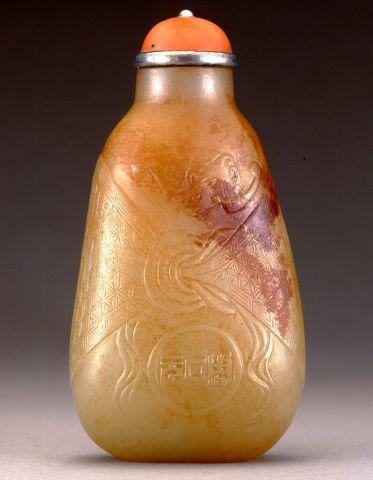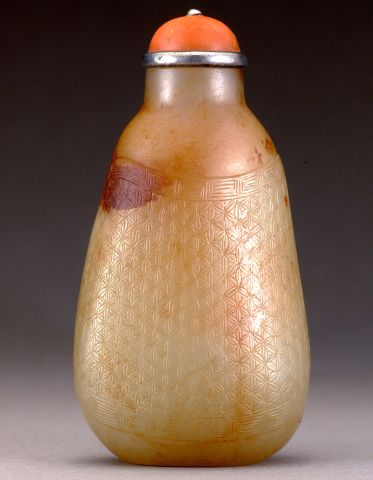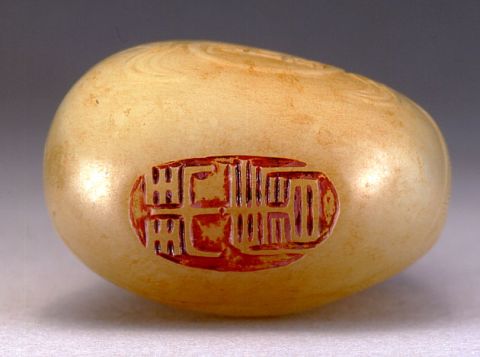


Bottle ID: 339
TRIANGULAR FORM WITH INCISED COIN
Date: 1736-1795
Height: 72 mm
Nephrite, of irregular triangular form, the yellow stone stained with russet patches and carved in very low relief with a patterned brocade shawl fastened on one side through a small ornamental circlet below which is carved an inscribed coin and above which is seen a bat in flight the base carved as a functioning seal in lishu script with two characters qin and shu.
Imperial, attributed to the Palace Workshops, Beijing.
Similar Examples:
Crane Collection nos. 121 and 639
Moss, Hugh, Victor Graham and Ka Bo Tsang. A Treasury of Chinese Snuff Bottles - The Mary and George Bloch Collection, 1995, Vol. 1, pp. 76-77, no. 26.
Sotheby's, New York, April 1, 2005, lot 400, Collection of Avrina Pugh.
Sotheby's, New York, September 14, 2010, lot 186, The Joe Grimberg Collection.
Provenance:
Clare Lawrence Ltd.
Sotheby's, New York, October 25, 1997, lot 87
Gerry P. Mack
Exhibited:
Annual Convention ICSBS New York, November 2013
Published:
JICSBS, Autumn 2005, p. 8, fig. 20
Moss, Hugh M. [ed.] Chinese Snuff Bottles: 3, p. 30, fig. 21, and p. 83, fig. 84
This is the only bottle known with a coin carved on it however the inscription on the coin is not complete because it should have four characters. It dates from the later zhou period of the five dynasties (951-960 AD.) and it can be dated to 955 A.D. when it was made by order of the Emperor Shizong. The characters read zhou yuan and the coin like many others was later considered a lucky talisman. It was thought to help women in childbirth and to assure good health for older people. The bat (fu) and sash (shoudai) constitute a rebus fushou wujaing (“may you enjoy boundless happiness and longevity”). The seal on the base is functioning because it includes the second character carved in reverse so that the owner of the bottle could use this as a personal seal. The two characters represent two of the four “arts of the scholar”, qin being the musical instrument usually called a lute and shu meaning books representing both literature and calligraphy (the other two arts were chess and painting).
Illustrated by Hugh M. Moss, in a special issue devoted entirely to the study of the Mack Collection, Chinese Snuff Bottles, Number Three, figs. 21 and 84, where the author discusses at length the quality and rareness of this truly remarkable snuff bottle.
< Back to full list

 English
English 中文
中文